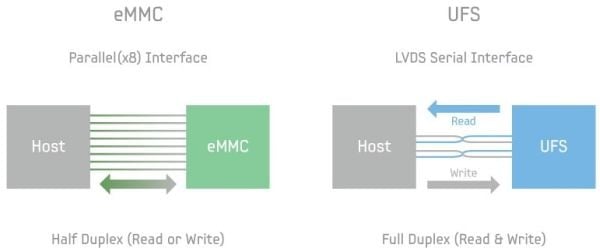
With the advancement of technology we are witnessing the improvement of many components of a smartphone, more or less quickly depending on the component taken into consideration (eg: CPUs evolve more frequently than display technology). In this sense, the evolution of photographic sensors and the increasingly growing trend of immortalizing every single moment of daily life with a single shot with consequent exhaustion of the storage space of the device, has led the producers of the same to implement ever greater memory cuts. (32/64/128 GB). Until now, Xiaomi (like all other manufacturers) has made use of eMMC type memories but in recent years greater emphasis is given to a new technology dedicated to data storage memories that is also mounted in the Xiaomi Mi 5, the UFS. But what's the difference between the two? And why will it become a standard for the top of the range?
THEeMMC (embedded MultiMedia Card), in essence, is equivalent to a micro-SD plus a controller (Parallel) but can not be removed because it is inserted (welded) inside an electrical circuit. Unlike a normal micro-SD, this memory has much higher performance values, as well as lower energy consumption and dimensions. It is present on any device that has an internal storage, such as smartphones, tablets, GPS systems, eReaders, and so on. The latest available version of this memory is the eMMC 5.1 (2015).
THEUFS (Universal Flash Storage) uses a high-speed LVDS (Low-Voltage Differential Segnaling) serial interface, which may vary between 2,9 Gbps up to 5,8 Gbps (comparable to those of an SSD), providing sequential writing / reading with less energy consumption than the eMMC. Virtually, this means: faster start-ups, significantly higher write / read speeds, and multitasking capabilities three times higher. So, you can play, play a high definition video, use various applications, download and upload files, all at the same time!
So, summarizing:
- The UFS has an interface LVDS with a separate write and read path that allows a real full duplex (works in two directions), that is, it can write and read at the same time. The eMMC, on the other hand, has a parallel interface that works in one direction, so it can read or write.
- The UFS has the Command Queue (CQ) which orders the commands to be executed. Thus, multiple commands can be addressed at the same time and the order of operations can be changed accordingly. The eMMC, on the other hand, does not have CQ (except for the eMMC 5.1) and this means that it has to wait for one process to complete before moving on to the next.
- These two features allow UFS 2.0 solutions to have sequential read and write performance, as well as random read and write, faster 1.4, 1.66, 2.71 and 1.07 respectively respectively than eMMCs.
With this type of memory, we can say that this year Xiaomi wants to make up for last year's lack of a top of the range and, in my opinion, it has succeeded. What do you think? Will Xiaomi succeed in winning you with this Mi 5?
via | Xiaomi Fans Italia










